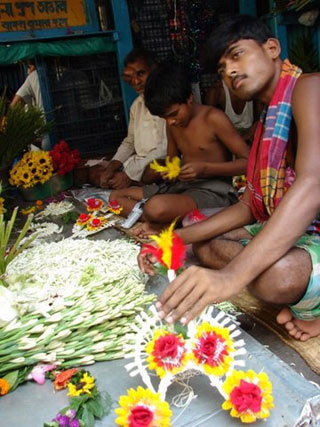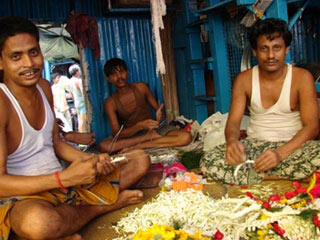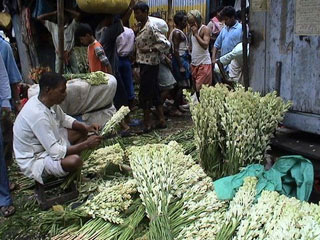Human Flower Project
Tuesday, May 22, 2007
Tuberose Tiaras for Brides and Gods
Sandy Ao finds Calcutta’s floral artisans at work on wedding crowns.

Making tuberose crowns at Mullickghat flower market
May 2007, Calcutta, India
All Photos: Sandy Ao
In May, Calcutta’s Mullickghat—one of the oldest and busiest outdoor flower markets in the world—sparkles. There’s romance in the air and, in nearly every stall, bushels of sweet white blossoms. Photographer Sandy Ao writes, “This season it’s more Tuberose and less of Marigold. The tuberose thrives well in the Indian summer heat, and it’s marriage season all over India.”
 Weaving rajniganda
Weaving rajniganda
“fragrance of the night”
May 2007
Sandy spent a morning down by the Hoogly bridge two weeks ago. She found scores of men and boys stringing the flowers of tuberose (Rajniganda) into spectacular wedding accessories. These blooms, while not so large or shapely as other flowers, are gleaming white and renowned for holding their fragrance. “The marrying couple exchange Tuberose garlands while giving vows during the marriage ceremony. Like the way others exchange rings,” Sandy explains. We’d seen pictures of the great tuberose garlands, thick as pythons, that wedding couples wear, but never these gorgeous tiaras!
“The crowns are for the Brides from the Eastern Region of India,” Sandy tells us. Typically, men teach crown-making to their young sons; working side by side, they thread the blossoms into pearly ornaments—exquisite pieces that sell, Sandy says, for Rs. 150 – 250 ($3.70 – $6.17 USD) apiece.
“I was informed most of the artisans are from the neighbouring state of Orissa,” just south of West Bengal, she writes. “They are traditional artists and able gardeners. Most of the florists who daily bring the flowers to the offices/shops/home,” in Calcutta, “are from Orissa.”
 Tuberoses arrive from Orissa
Tuberoses arrive from Orissa
Mullickghat market, Calcutta
Sandy wandered among the artisans as they wove and traded … “with all these flower sellers and buyers busily bargaining the price, one tends to forget that we are living in modern times. Time just stands still… we don’t see any crooked person and face no danger of being robbed or mugged. I guess no one has the time for anything other than buying flowers or selling flowers. In between there are vendors selling country made ice cream or homemade soft drinks… and some fresh fruit sellers, and tea makers, and lunch makers… and the Barbers busily shaving or cutting hair!” Sandy writes, “After a few months when the monsoon sets in, the Marigold will take over the market scene.” But for now, tuberose presides—in its glory.
 Crown fit for a bride
Crown fit for a bride
tuberoses, sunflowers and roses
Polianthes tuberosa is a welcome and omnipresent wedding guest, especially in Bengal. Bright and sweet, it appears in crowns and garlands, also in decorations for the couple’s getaway car and even the marriage bed (Phul Shajya). Rajniganda translates as “fragrance of the night.”
We hope someday to see a 1974 movie called Rajniganda (Tuberose) —you guessed it , a love story. In the film, a young woman is torn between her hometown sweetheart and go-getter she meets in Bombay. As she mind-wrestles to know which man is her soul mate, the gift of tuberoses—that fragrance!—brings an answer.
By the way, “Tuberose is known to improve one’s capacity for emotional depth. By opening the crown chakra it improves psychic powers.” How fitting that a bride would wear rajniganda on her head. “And these are for the God Lord Shiva,” Sandy writes. “Some of the flower sellers told me they can use these crowns for the God /Goddess and the brides. I guess all are pure and holy in the same manner!”
Cut-Flower Trade • Florists • Religious Rituals • Secular Customs • Permalink




